Thursday, February 7, 2013
Moving Day!
My daughter has been setting up a new site for me that will have fewer problems with fonts and other issues. All previous posts will stay here, but will also appear, along with all new posts, at www.conservationbigyear.com
Species of Concern: Loggerhead Shrike
 |
| Loggerhead Shrike |
When I bird in Florida, I’m ever scanning fence posts and
power lines in hopes of seeing Loggerhead Shrikes.
Shrikes are predacious
songbirds, but that’s not very exceptional—so are chickadees, robins, and
bluebirds, the insects and worms they eat being very much animals. Shrikes feed
on small lizards, birds, and mammals as well as insects, but so do some crows,
ravens, and even large flycatchers. The difference is that shrikes eat meat
almost exclusively, with physical and behavioral adaptations unique among
songbirds. The hooked beak tip and sharp notch near the tip help grab and sever
the spinal cord of small vertebrates. When a shrike bites off more than it can
chew in one meal, so to speak, it can impale whole prey or parts on thorns or
barbed wire, or wedge it into the fork of a branch, both for easier killing and
for longer-term storage. This habit led to the family nickname, “butcherbirds.”
The proportionally large head of all shrikes is particularly highlighted in the
Loggerhead Shrike’s name, a synonym for “blockhead.” Of the 30 or so species in
the family, only the Loggerhead is entirely restricted to North America. It’s a
little smaller and daintier than the Northern Shrikes we see up here in winter.
And Loggerhead Shrikes eat fewer rodents and birds, focusing heavily on
grasshoppers.
 |
| Loggerhead Shrike eating grasshopper |
Loggerhead Shrikes used to be fairly regularly seen in
southern Wisconsin and Minnesota, but they declined drastically through the
last half of the twentieth century. They’ve essentially vanished from the
northeastern part of their range and continue to decline everywhere else. The
subspecies on San Clemente Island in California is listed as endangered on the
federal list.
 |
| Breeding Bird Survey numbers: Loggerhead Shrike decline in Wisconsin |
 |
| Breeding Bird Survey numbers: Loggerhead Shrike decline in Minnesota |
I’ve visited Florida almost every year since our son Joe
moved there in 2003. I have a much harder time finding them now than I used to
down there, and the steep decline shown in Breeding Bird Survey numbers for
Loggerhead Shrikes in Florida between 1966 and 2010 bears graphic testament to
my experience. I find it endlessly frustrating that despite the dramatic
decline virtually everywhere, they aren’t on the federal list for endangered,
or at least threatened, species.
 |
| Breeding Bird Survey numbers: Loggerhead Shrike decline in Florida |
 |
| Breeding Bird Survey numbers: Loggerhead Shrike decline in United States |
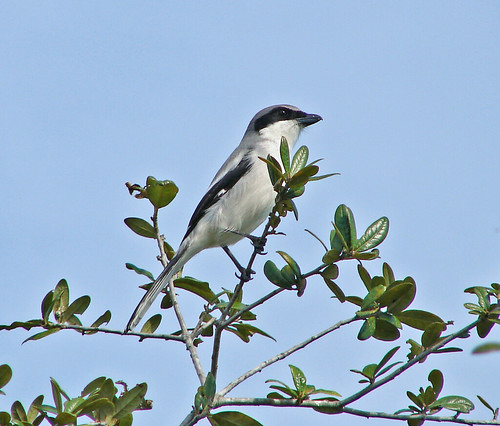 |
| Russ and I watched this breeding Loggerhead Shrike at a Nature Conservancy/Disney property in Florida in 2005. |
Overall, Loggerhead Shrikes seem a little calmer in the
presence of gawking birders than Northern Shrikes usually are, but even they
are a bit skittish. In January I came upon one while on a pleasant drive from
Titusville to New Smyrna Beach in Florida. It had caught a large grasshopper
and was starting to eat it. I stopped momentarily when I spotted it and snapped
a few photos from my car window, but I did not want to risk frightening off the
little predator, especially since he might have lost the morsel, so I drove on.
We humans haven’t left them much space and our pesticides kill many of their prey,
but these handsome songbirds deserve our respect and affection.
 |
| Loggerhead Shrike with grasshopper |
Monday, February 4, 2013
February 3: Superb Owl Sunday
 |
Several years ago, I realized that by just adding a properly
placed space, I could transform Super Bowl Sunday into Superb Owl Sunday. Last
year Russ and I were in New York City visiting our daughter Katie and her S.O. Michael
on the big day. We decided to head out to Breezy Point Tip on the city’s ocean
front to at least get out into the wild for a while, when what to our wondering
eyes should appear but two Snowy Owls! One was a very mature adult male, his
plumage snow white. I’ll never forget that thrilling and unforgettable day,
even richer for sharing it with my family.
 |
| Snowy Owl in NYC on Superb Owl Sunday, 2012, not enlarged or cropped |
 |
| That Snowy Owl after cropping |
This year I was certain things couldn’t possibly go that well ever again on
Superb Owl Sunday, but figured I might be able to see an owl somewhere. During the past two weeks, Boreal Owls have been appearing
all over between Duluth and Two Harbors, and a few weeks ago, Ryan Brady even
had one in his yard in Washburn, Wisconsin, and so birders from all over the
country are descending upon Duluth to see them. Boreal Owls periodically
“irrupt”—that is, large numbers of them suddenly appear well south of their
breeding range. This is a well-known, if rare, phenomenon. Birders rejoice,
because except in rare years like this, this secretive owl is one of the
hardest of all regularly occurring North American birds to add to a lifelist,
but it’s a mixed blessing because the adorable little predators are so
desperately hungry that they must hunt at midday, usually coming up empty. Tour
groups are seeing as many as seven in a single day, but I feel like I’m gawking at someone in their time of misfortune, so I seldom go out to
look for them.
But yesterday being Superb Owl Sunday, my doing a big year, and Russ
and I having a couple of free hours, we headed up to Two Harbors. I was hoping
we’d luck into spotting a Boreal Owl tucked into a conifer somewhere along the scenic
highway—owls hiding out in spruces and cedars probably had successful hunting
the night before. It’s tricky to spot one when zipping by in heavy traffic, but
when so many birders are afield searching, one may spot a pack of birders
already watching one. Russ and I had no such luck, so when we got to Two
Harbors, we headed straight to Fourth Avenue—there’s a 2- or 3-block alley
behind the houses there where I’ve seen Boreal Owls several times in the past.
We spotted seven deer, including a handsome buck, but didn’t hear or see a
single chickadee, much less a Boreal Owl.
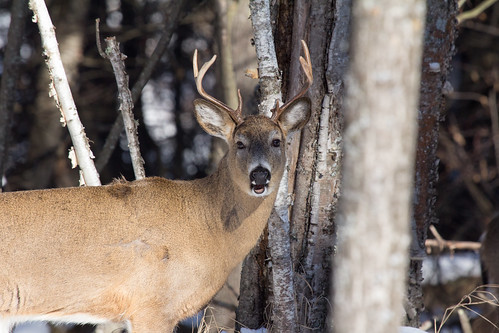 |
| This and six other deer walked past us in the woods behind the alley |
Right as we were growing discouraged, from the road above, one
of my birding friends spotted me and drove down to the alley to tell us about a
saw-whet owl he’d seen just a few blocks away. If I were to come up with a top
ten list of my favorite birders in the world, Jim Lind would
definitely be on it. He’s a great and generous birder who produces our
area’s weekly rare bird reports and compiles the Duluth Christmas Bird Count. In years like this, Jim spends his free time searching out good
birds in Two Harbors, and obviously goes out of his way to help other birders see them. And he has the
best Boreal Owl Karma of anyone in the known universe. He hadn’t spotted one yet
in Two Harbors on this Superb Owl Sunday, but the even tinier owl he’d spotted
a little while before was a great sighting. We chatted for a few minutes, until
he had to be going and we were ready to move on for the Saw-whet. We said our
goodbyes, and right as he was turning away, his eyes locked on a Boreal Owl
only about 15 feet away! Right there in the open, right beside us!
 |
| See what Jim Lind found? Right next to us!! Was the little owl there all along? |
The bird was alert, so focused on searching for the sounds of small mammals that s/he ignored us. When Jim moved on, I kept photographing the little thing.
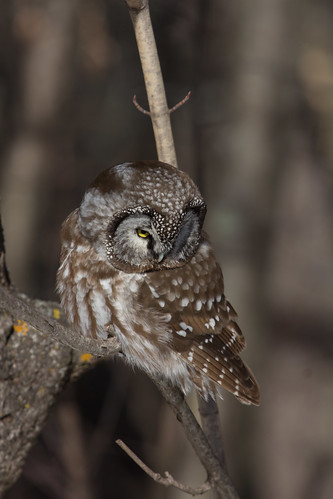 |
 |
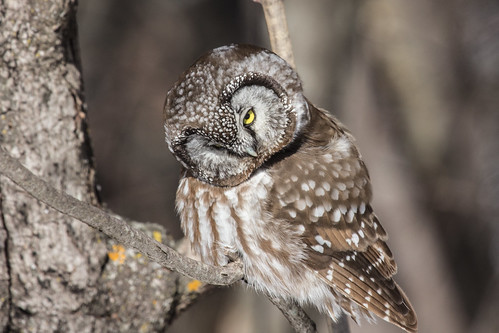 |
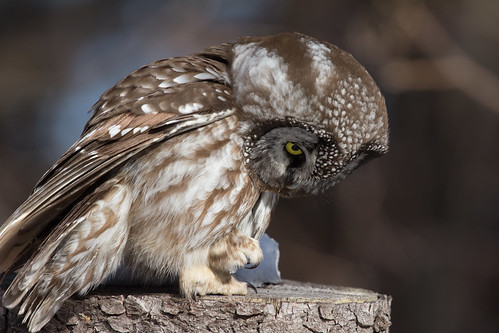 |
| The left foot appears to be injured, though s/he managed to catch and carry a shrew. |
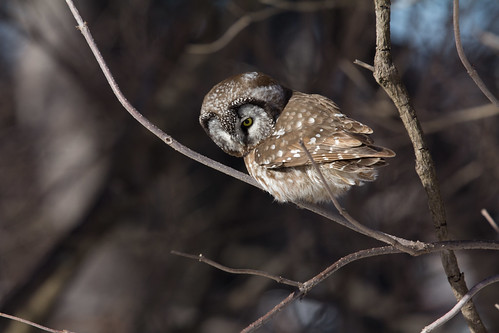 |
 |
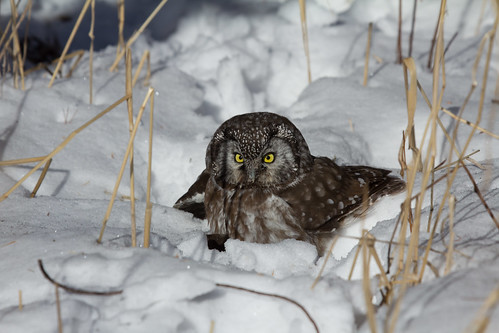 |
 |
| This chickadee was saying several naughty words! |
The Boreal Owl took off, carrying a nice hot lunch with him/her, and dropped
down on the ground behind a fallen log under a tangle of branches to try to eat
in peace. Russ and I walked away in great relief that the little mite wouldn’t
spend the day hungry.
 |
| Going off to eat in peace! |
If this 20-minute encounter with a Boreal Owl wasn’t enough,
we went to the spot where Jim Lind’s Saw-whet Owl was spending the day. That
little guy was roosting on an exposed branch, carefully keeping both eyes closed
to avoid notice by chickadees. Some people spent last evening watching a flock
of ravens playing football, but not us. We’d already experienced the best
Superb Owl Sunday ever.
 |
| Northern Saw-whet Owl |
Total miles for day: 65. New species bringing total for year to 188:
- Boreal Owl
- Northern Saw-whet Owl
Sunday, February 3, 2013
February 2: Duluth Audubon field trip to the Sax-Zim Bog
Below zero temperatures tried to put the kibosh on Duluth Audubon's annual Sax-Zim Bog field trip. The temperature in double digits below zero kept our bus from starting. While things were still in flux, we had a quick but delicious and hot breakfast at Perkins, and then decided to carpool. That was fun! I rode with a lovely couple named Charlie and Diana, with another fun birder, Elsa, along in our car as well. Elsa picked out our first bird of the day! Not quite a real one, but even an owl decoy can be fun to see.
The real birds we had in the bog were splendid! We started out at the community center, wandered up toward Owl Avenue and the large feeding station Sparky Stensaas and the Friends of Sax-Zim Bog set up. It's become a great stop!! From there we worked up to the Admiral Road feeders, then back to the Community Center, on to the Little Whiteface Road feeders and the Blue Spruce feeders, and home. What a great day! No owls, but the temperature warmed from -19 degrees to a right balmy +10, and we had plenty of other birds:
 |
| Our first bird of the day! Elsa spotted this owl. We didn't even mind that it was fake. |
- Ruffed Grouse
- Bald Eagle
- Rough-legged Hawk (people in some cars saw)
- Red-tailed Hawk (one along Highway 53 on the way home--I don't know if people in other cars saw this one)
- Downy Woodpecker
- Hairy Woodpecker
- Northern Shrike (not everyone got a good look at this one)
- Gray Jay (Great looks for everyone! There were five at the Admiral Road feeders!)
- Blue Jay (two were all fluffed up and looking rather unhappy first thing this morning)
- Black-billed Magpie (this would have been my first sighting of the year if only I'd seen them! But some people got a quick but very nice look.)
- American Crow
- Common Raven
- Black-capped Chickadee
- Boreal Chickadee (two at the Admiral Road feeders)
- Red-breasted Nuthatch
- White-breasted Nuthatch (only at the Blue Spruce feeders)
- Brown Creeper (one in the trees and on the ground near the Friends of Sax-Zim Bog feeders)
- European Starling
- Pine Grosbeak
- Common Redpoll
- Hoary Redpoll (ALL of my photos of these didn't turn out! But we had great looks at three different feeding stations)
- American Goldfinch (at least one with the House Sparrows and redpolls in the trees across the street from the Community Center)
- Evening Grosbeak (the only place we saw these was first thing in the morning, in trees across the street from the Community Center)
- House Sparrow (Our hopes of a "clean count" were destroyed first thing in the morning at the Community Center)
 |
| Ruffed Grouse feed on aspen buds in winter. If you look carefully, you'll see the little grippers on its toes--they help when branches are icy! |
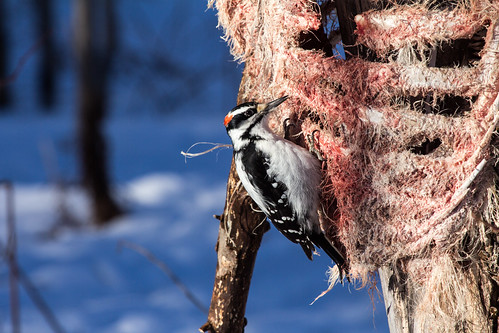 |
| Hairy Woodpecker feeding on a deer's ribcage at what I call "Sparky's feeding station" on Owl Avenue. |
 |
| Downy Woodpecker at suet. |
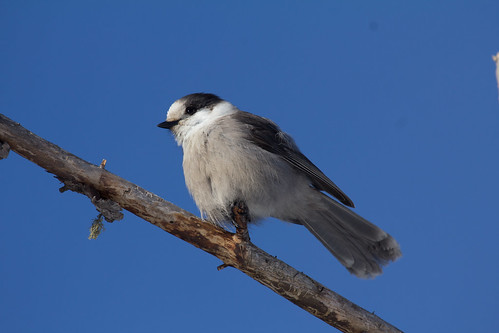 |
| Gray Jay! There were at least 5 visiting the Admiral Road feeders. |
 |
| Gray Jays look like chickadees on steroids. |
 |
| Boreal Chickadee at the Admiral Road feeders |
 |
| Boreal Chickadee |
 |
| Red-breasted Nuthatch--a pretty male |
 |
| This Brown Creeper was feeding in this tree and on the ground at the Owl Avenue feeding station. |
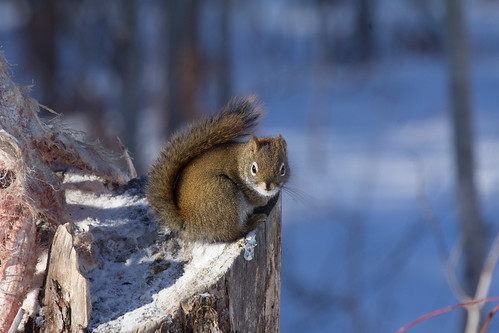 |
| I love red squirrels! |
February 1: Frozen morning with Erik Bruhnke
 |
| Steamy Lake Superior in Two Harbors |
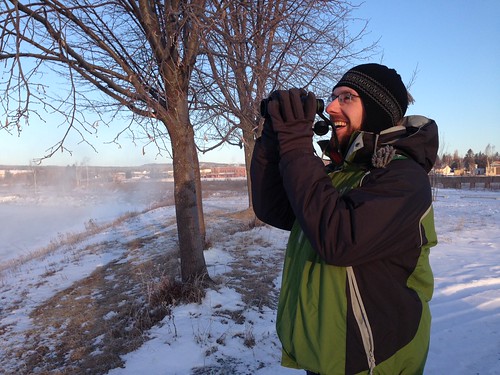 |
| Erik Bruhnke |
Saturday, February 2, 2013
January 31: First month wrap up
Home to cold little chickadee toes on my fingers! And a Red-bellied Woodpecker showed up to ease the transition from Florida to the frozen northland. Total miles on the trip: 4309 (plus the miles with Mike McDowell). Total species for the month: 186.
January 30: Wild goose chase
Greg Neise posted on facebook last night that a Barnacle Goose had been seen yesterday on Lake Bloomington in McLean County in Illinois. Today seemed like a good day for geese, especially after I saw a handful of Snow Geese (new for the year) not far from the Kentucky/Illinois border. And turns out my GPS was sending me right past an exit just a few miles from where it was seen. There was a lot of bad weather before and behind me, but when I got to Bloomington, it was just cold and blustery, not raining or snowing, so off I went on my wild goose chase.
No luck on the Barnacle Goose, but added two more geese to my year list, and met a couple of really nice birders who'd been searching for the Barnacle Goose all day. So I'm very glad I made the stop even though I got skunked on the bird I was searching for. I had a long way to go still, but made it home in one piece before 10:30. New for year, bringing my total to 186:
No luck on the Barnacle Goose, but added two more geese to my year list, and met a couple of really nice birders who'd been searching for the Barnacle Goose all day. So I'm very glad I made the stop even though I got skunked on the bird I was searching for. I had a long way to go still, but made it home in one piece before 10:30. New for year, bringing my total to 186:
- Snow Goose
- Greater White-fronted Goose
- Cackling Goose
- Gadwall
January 29: On the road again
I woke up to Northern Gannets visible from my motel balcony while I packed up, and then headed on towards home. Drove and drove and drove till I got to Kentucky.
Tuesday, January 29, 2013
January 28: Pelagic Trip!
 |
| Northern Gannet adult |
I spent 12 hours in a
boat on the Atlantic Ocean, far from the Florida shore, doing what is called
“pelagic birding.” (It's just a fancy word meaning we're out far, far from shore.) The cruise was the
final field trip for the Space Coast Birding and Nature Festival, and was the
perfect way for me to close my Florida adventure before starting the long drive
home.
It was possible I could add a bird or two to my lifelist on
this trip, and I’m always excited about that possibility, but the Atlantic
Ocean is vast and even with 110 pairs of eyes looking every which way, it’s
easy to miss birds. So I went out open to anything, with only one actual
goal—to take at least one or two good photos of the Northern Gannet, a bird I
figured we couldn’t possibly miss.
Gannets belong to the family Sulidae, along with boobies. Boobies
nest in southern seas, but gannets breed on rocky cliffs in the North Atlantic, where they are the largest breeding seabird. Two thirds of the world’s gannets
nest in the U.K., mostly in Scotland. The rest breed mostly off Canada,
Ireland, the Faroe Islands, and Iceland.
Gannets breed far from the Florida coast, but a great many migrate here
in winter, and young birds remain on the Atlantic off Florida and in the Gulf
of Mexico for two or more years before returning north to begin breeding.
The gannet is quite abundant still, so is not listed as a
bird of conservation concern, but I consider it one, because the way we’re
trashing the ocean is making all ocean life so vulnerable. On our cruise,
although my eyes were mostly focused all about searching for birds, I did spot
three bits of plastic trash floating about.
We also saw two container ships. Most boats are far, far more polluting than automobiles, but we don’t seem to worry about boating and ship pollution at all. We cleaned up auto emissions after it became clear that lead in the air we breathe was hurting humans, but we don’t seem to care what we put into salt water. Container ships are especially polluting because they burn bunker fuel—the filthy sludge left over from crude oil after gasoline, propane, and kerosene have been refined out. Every article we purchase from China is cheaper than what we can manufacture in America not only because labor is so cheap and there are few environmental controls to require companies to minimize pollution, but also because we can transport those items to America so cheaply via these horrifically polluting vessels. And because all countries share the ocean, there’s little any country could do to clean up the mess, even if any country wanted to, which none seem to.
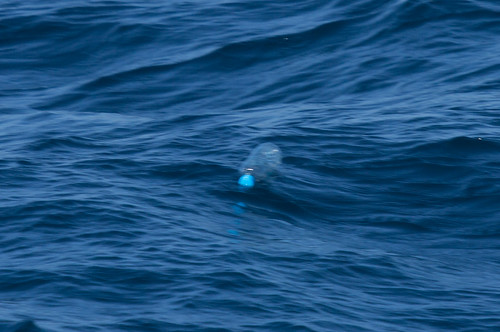 |
| Yuck |
We also saw two container ships. Most boats are far, far more polluting than automobiles, but we don’t seem to worry about boating and ship pollution at all. We cleaned up auto emissions after it became clear that lead in the air we breathe was hurting humans, but we don’t seem to care what we put into salt water. Container ships are especially polluting because they burn bunker fuel—the filthy sludge left over from crude oil after gasoline, propane, and kerosene have been refined out. Every article we purchase from China is cheaper than what we can manufacture in America not only because labor is so cheap and there are few environmental controls to require companies to minimize pollution, but also because we can transport those items to America so cheaply via these horrifically polluting vessels. And because all countries share the ocean, there’s little any country could do to clean up the mess, even if any country wanted to, which none seem to.
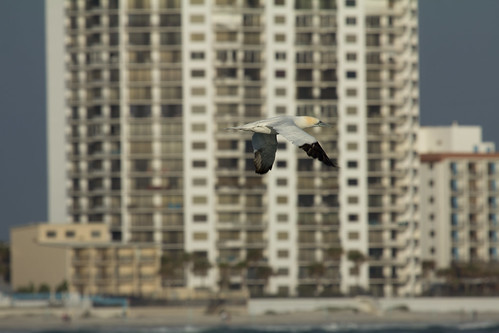 |
| It's so weird to see this bird of rocky wild islands of the North Atlantic flying so close to massive developments. But where else can they go in winter? |
The gannet was the
bird most often collected dead or badly oiled after the BP oil spill. I was
very disturbed when I attended a “media event” at one of the rehab centers
following the spill to hear the spokesman from the US Fish and Wildlife Service
explain that the reason every gannet thus far collected was an immature was a
mystery, but that apparently the adults had figured out how to avoid oil
plumes. No—the reason was that all the adults were far from the Gulf when the
spill occurred—already wending their way north to their breeding grounds. I
couldn’t believe he didn’t at least look the bird up in a field guide to figure
this out. But like everything else about the spill, the media seemed to swallow
everything BP said without questioning it.
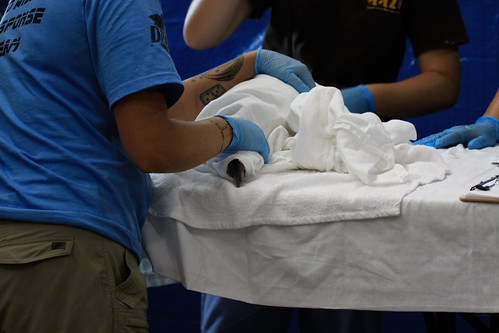 |
| This poor first-year Northern Gannet had been oiled in the BP oil spill, and was being cared for at a rehab center in Alabama. |
On my pelagic trip, I tried not to think too much about
trash and oil spills and bunker fuel and the many other ways we pollute the
ocean while I was watching gannets. They’re gorgeous in flight or swimming, and
I managed to get dozens of reasonably good photos of them. They were gathering
near the boat because the crew was “chumming”—that is, tossing out fish oil and
fish guts and popcorn out the back to lure in gulls, which often attract
curious seabirds from a distance.
The gannets watching this were diving from only ten or twenty feet above the water, though when actively fishing, may dive from as much as a hundred feet above the surface. They manage this because their nostrils are located in their mouth rather than externally, they have air sacs under the skin of their face and chest that act as bubble wrap to soften the blow when they hit water, and their eyes are located forward, providing binocular vision to accurately judge when they’ll hit. They dive so frequently that the word “gannet” has come to refer to a glutton.
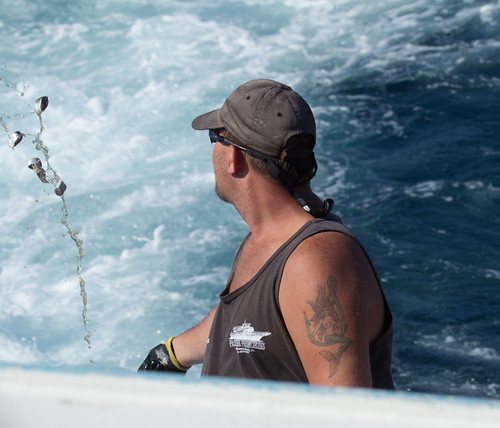 |
| Tossing out "chum" |
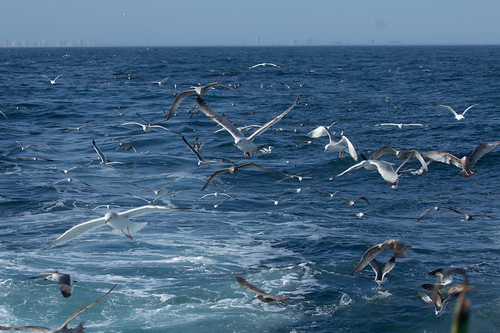 |
| Gulls following the boat to gobble up "chum" |
The gannets watching this were diving from only ten or twenty feet above the water, though when actively fishing, may dive from as much as a hundred feet above the surface. They manage this because their nostrils are located in their mouth rather than externally, they have air sacs under the skin of their face and chest that act as bubble wrap to soften the blow when they hit water, and their eyes are located forward, providing binocular vision to accurately judge when they’ll hit. They dive so frequently that the word “gannet” has come to refer to a glutton.
 |
| Next time I'll try to take an action shot that's in focus. |
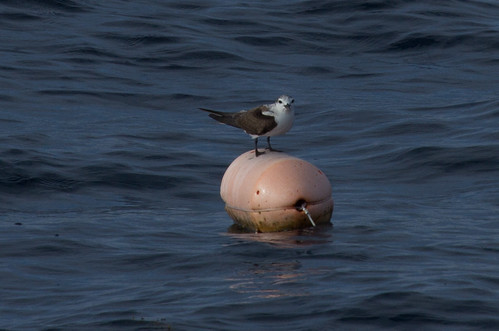 |
| Bridled Tern |
 |
| Baby Green Seat Turtle about to be released gently into the big big ocean |
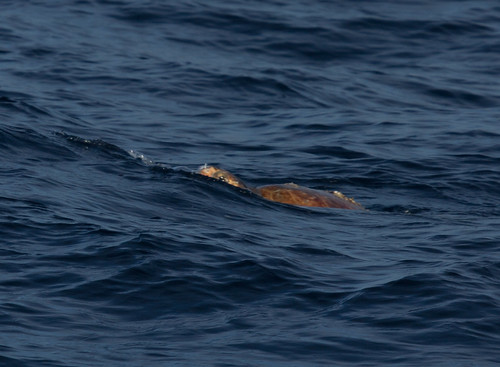 |
| Adult sea turtle seen from the boat |
I reached my goal on this perfect day, and will head home with happy memories of my favorite seabird and a lovely voyage.
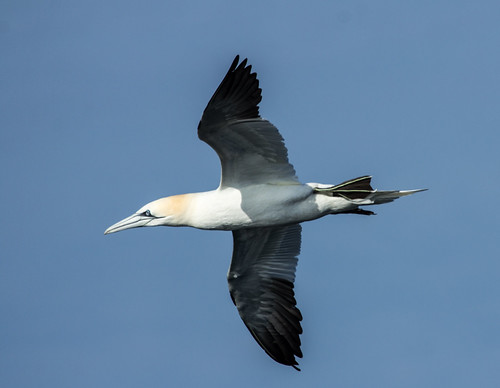 |
| Mission accomplished! |
- Cory's Shearwater
- Brown Booby
- Red Phalarope
- Lesser Black-backed Gull
- Bridled Tern
- Black Tern
- Pomarine Jaeger
- Parasitic Jaeger
- Razorbill (These poor birds are also being found dead or dying along the Florida coast this year--they are probably here due to the hurricane, and somehow I didn't feel very happy seeing this one.)
January 27: Blue Heron Sewage Treatment Plant, Merritt Island, and moving on to Daytona
I started out my morning in a literal fog. I checked out of my motel and drove a few blocks to the Blue Heron Sewage Treatment facility, where birders are welcome! I added four new species there:
- King Rail
- Sora
- Purple Gallinule
- Swamp Sparrow
Then I stopped at Merritt Island's visitor center one last time before heading on to the Brevard County Community College to give my program about the herons viewed in Cornell's nest cam. It was the last regular program of the festival, at lunchtime when people were packing up, so I can blame that on the poor attendance--about a dozen people showed up in the rather large auditorium. Oh, well--I prefer intimate little gatherings anyway.
Then it was time to wend my way up toward Daytona so I wouldn't waste too many extra miles driving back and forth to New Smyrna Beach, where the pelagic trip would be leaving from. En route I FINALLY saw one Black Skimmer, and when I reached my hotel room, got my first gannet!
- Northern Gannet
- Black Skimmer
My year's total is now 173.
January 26: Enchanted Forest Sanctuary field trips
For the past few years, Joe Swingle and I have led a field trip for "beginners" at Brevard County's lovely Enchanted Forest Sanctuary, where Joe is a naturalist. This year we led two. Bill Thompson from Bird Watcher's Digest came along on one to help. Between field trips, I went back to Merritt Island briefly, where I saw the male hummer who's been visiting the feeders at the visitor center.
New birds, bringing my total to 167:
New birds, bringing my total to 167:
- Eastern Screech-Owl (I heard it make the whinny call twice. Archimedes has been calling lately, and my missing him is probably why my ears picked it out.)
- Ruby-throated Hummingbird
- Yellow-bellied Sapsucker
- Orange-crowned Warbler
Friday, January 25, 2013
January 25: Moore Cultural Center and Merritt Island
Led a field trip to the Moore Cultural Center. People there are interested in making the grounds into a welcoming bit of habitat. After the field trip and a bit of lunch, I went to Merritt Island, to the Visitor Center, along the Wildlife Drive, and to the Scrub-Jay area. Brought my total to 163 with these new species:
- Eurasian Wigeon
- American Wigeon
- Northern Pintail
- American Avocet
- Greater Yellowlegs
- Lesser Yellowlegs
January 24: Viera Wetlands!
I spent the entire morning, from about 8:15 until 2 pm, at the Viera Wetlands and the "Click Ponds" that start near the entrance going the other direction. Had wonderful looks at a river otter and a family of raccoons, as well as plenty of birds. My total is now 157 thanks to these new species:
- Mottled Duck
- Blue-winged Teal
- Green-winged Teal
- Ring-necked Duck
- Wild Turkey
- American Bittern
- Least Bittern
- Glossy Ibis
- Common Gallinule
- American Coot
- Limpkin
- Barred Owl
- Tree Swallow
- Barn Swallow
- Marsh Wren
- Common Yellowthroat
- Savannah Sparrow
- Painted Bunting
January 23: A Scrub-Jay Day
This was a wonderful day! I started out at the Florida Scrub-Jay Trail, then moseyed to Lake Kissimmee State Park, then had to get to my son's place in Davenport where we had dinner, and then I headed on to Titusville. I'm just posting the basic statistics right now, but will add photos and a lot more information about the day and places ASAP. I had 11 new species, bringing my total to 139. New species:
- Northern Harrier
- Loggerhead Shrike
- White-eyed Vireo
- Blue-headed Vireo
- Florida Scrub-Jay
- Blue-gray Gnatcatcher
- Ruby-crowned Kinglet
- Pine Warbler
- Eastern Towhee
- Bachman's Sparrow
- Red-winged Blackbird
January 21-22: Day at Disney and driving
I wish the management of Disney World had a naturalist at each theme park pointing out the cool wild birds around. I didn't get any year birds at Disney or in the Orlando area (not after yesterday's Hooded Merganser, anyway), and didn't see any new ones along the drive back to Sarasota where I said farewell to Mr. B and headed on to the Florida Scrub-Jay Consortium, where my dear friends Bruce and Cathy Brown are doing admirable work trying to get private landowners to work together to manage property for Florida Scrub-Jays. I got there quite late in the day, and though I spotted one in the distance, decided to wait till I see it better tomorrow before I count it. I'm scrambling to catch up on posts for people who want to know what I've been seeing, but will write a lot more about Bruce and Cathy's work, and why they deserve our support, as soon as I can. New bird (oh, well--had to see them eventually) brought my total to 128:
- Brown-headed Cowbird
January 20: Longboat Key and on to Orlando
I took a short stroll on a beach on Longboat Key near Sarasota this morning. It was quiet bird-wise and some little kid was chasing shorebirds. I told him and his parents that these birds travelled thousands of miles to rest here, but they said there are thousands of miles of beaches they could move to. Oh, well. THAT was depressing! The beach is beautiful.
Mr. Borkowski and I headed off to Orlando for my personal "Take Your Fifth Grade Teacher to Disney World Day." He spotted my year Cattle Egrets along our drive, and in back of our hotel in Kissimmee, there were Hooded Mergansers, so oddly enough, I got a year bird in one of the most developed parts of the state. Joey came to the hotel where we ate dinner together. He took this photo of me and Mr. B.
My new birds brought my total to 127:
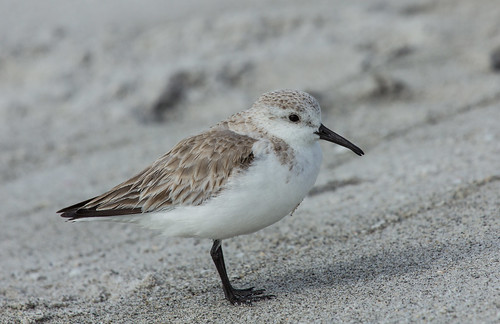 |
| Sanderling |
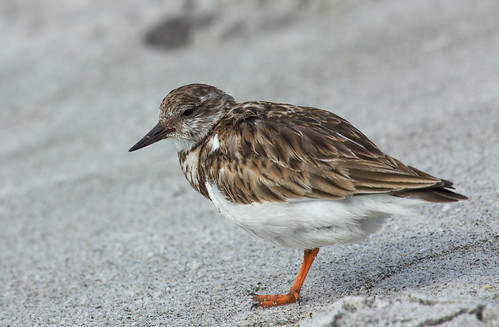 |
| Ruddy Turnstone (They use that cool wedged beak to turn over stones!) |
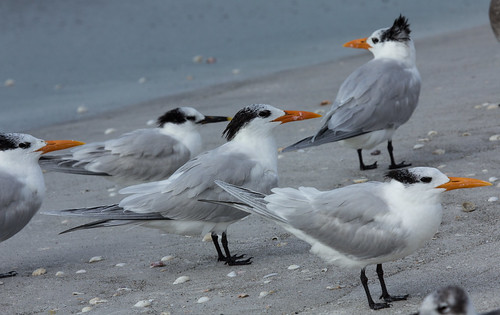 |
| Royal Terns with one Sandwich Tern in back. |
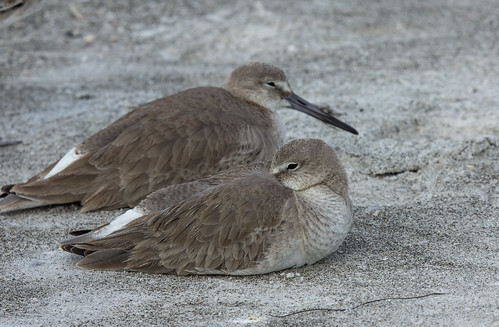 |
| Willets resting up before the little boy chased them away |
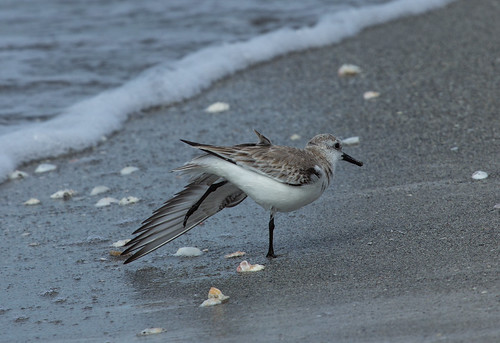 |
| Doin' the Sanderling Stretch |
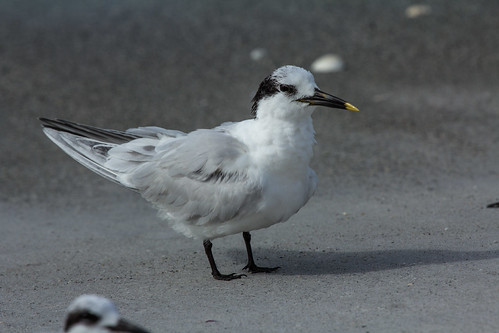 |
| Sandwich Tern |
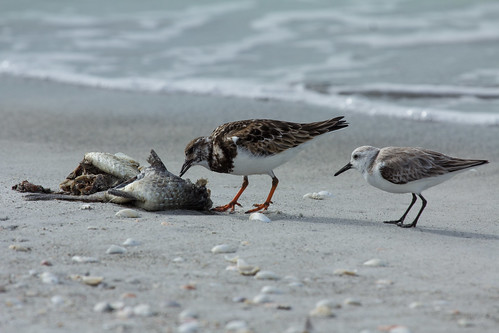 |
| The Sanderling kept creeping in and taking tiny bites before the Ruddy Turnstone chased him away. Fish for breakfast! |
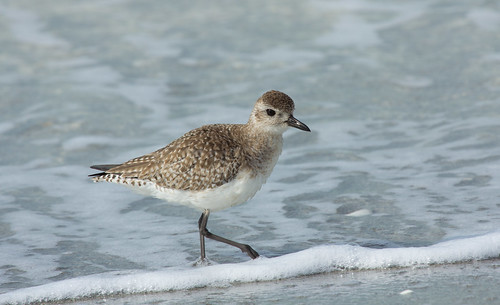 |
| Black-bellied Plover |
My new birds brought my total to 127:
- Hooded Merganser
- Cattle Egret
- Sandhill Crane
- Spotted Sandpiper
- Sandwich Tern
Subscribe to:
Comments (Atom)

